Idea by
Rosa Whiteley
Afterbodies
https://rosawhiteley.cargo.site/
Call for ideas 2021
WEIRD ASSEMBLAGES
WEIRD ASSEMBLAGES
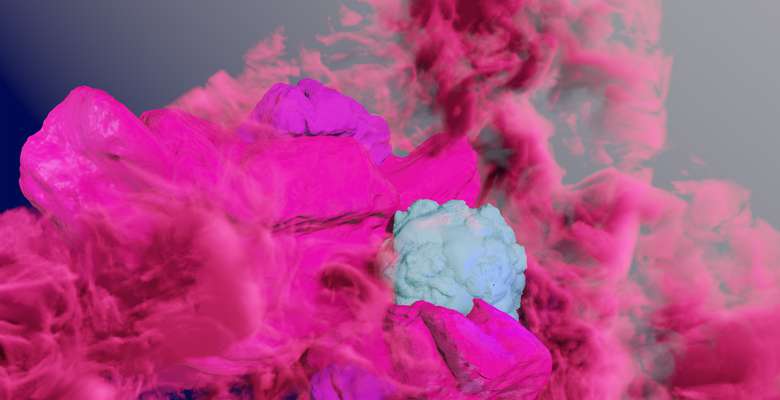
- New alliances
My practice explores uncanny multispecies relationships that form around systems of pollution and spaces of residue. I explore landscapes through globalised infrastructures, questioning what landscapes and architectures may exist in the residual spaces of the technosphere we inhabit.
‘Weird Assemblages’ live fiercely and resiliently within the material traces of our infrastructural systems. They are an entanglement between bodies of air, bodies of toxins, living bodies and the bodies of the dead. Examples of these include the fauna that thrive in our polluted air; wild flowers that flourish in car exhausts; radiation eating berries; algae living through the carbon molecules in ice sheets and toxicity-resistant killifish. A multi-media catalogue of these weird assemblages will build a narrative of our landscapes as more-than-human assemblages of resilience, encouraging forms of architecture that both learn from these acts of resilience, and form a collective alliance within them.
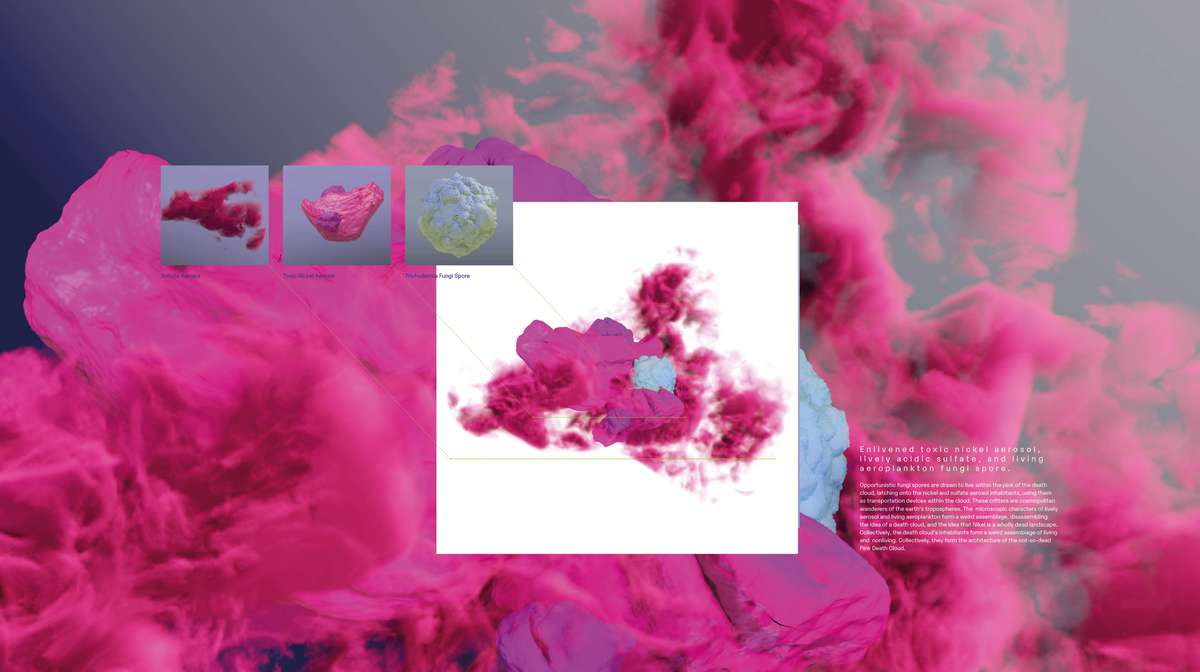
The Weird Assemblage of Nikel’s Death Cloud: Enlivened toxic nickel aerosol, lively acidic sulfate, and living aeroplankton fungi spore. Opportunistic fungi spores are drawn to live within the pink of the death cloud, latching onto the nickel and sulfate aerosol inhabitants, using them as transportation devices within the cloud.
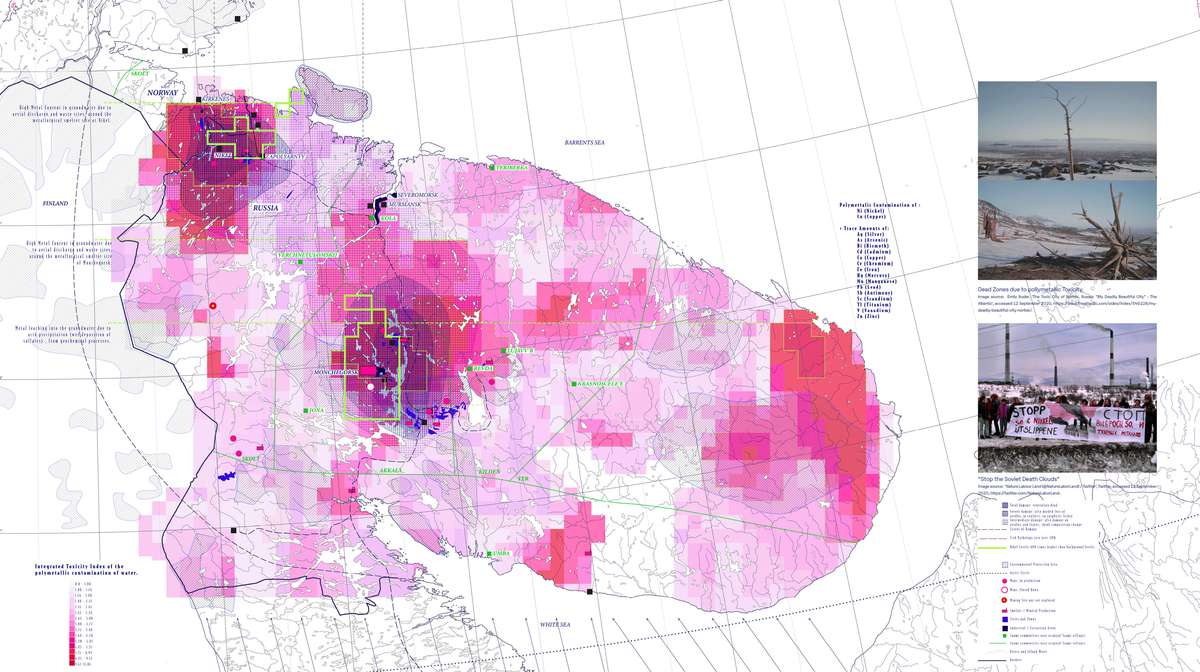
The Metallic Footprints of the Death Clouds across the Kola Peninsula - In this land of accumulation, the earth, forests, rivers, and air of Nikel have become defined through metallic landscapes of death and residue. By tracing the toxic residue of the death cloud, we trace the footprint of the atmospheric weird assemblage of metal aerosol and conjoined fungal spore. As Mel Chen states, “This toxin is not alive, yet it enlivens morbidity in the fear of death.”
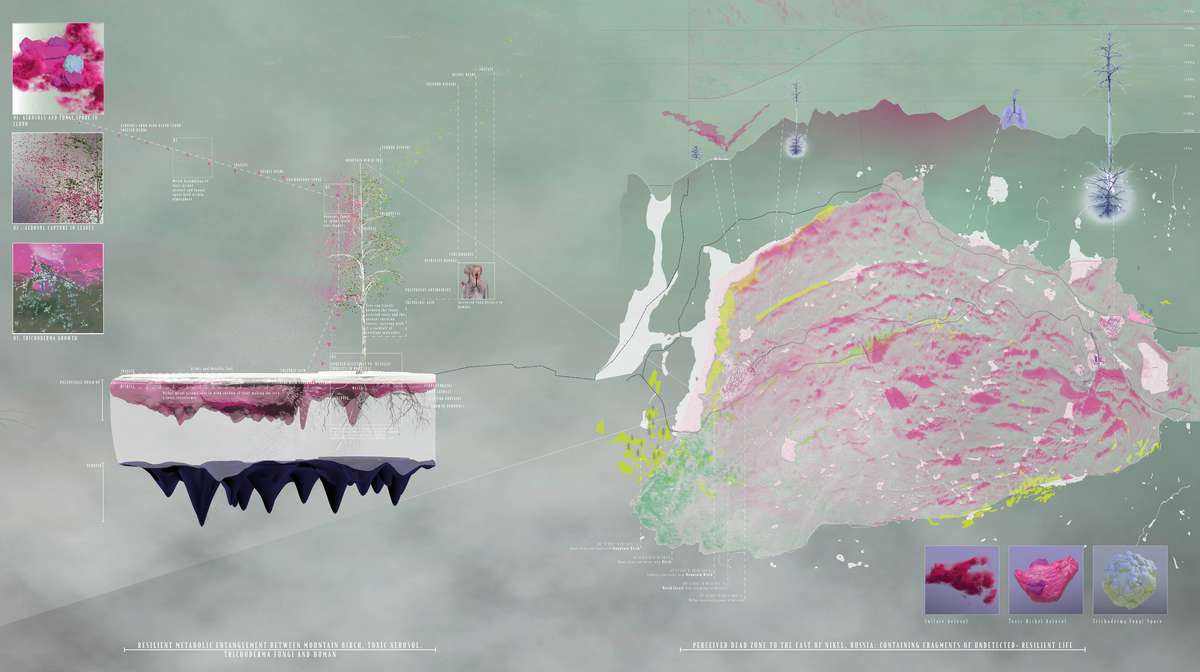
The Earthly Inhabitants of the Death Cloud - Mountain Birch trees have developed a metallic toxicity resistance within their saplings; within Nikel’s ‘dead zone.’ The leaves of these trees contain microscopic hairs that act as aerosol traps; catching the spores and toxic particles as they pass by, encouraging them to land in the soil. The weird assemblage spread from air to ground, with the tree and fungi entering a constant exchange of resilient chemicals within the tree roots.
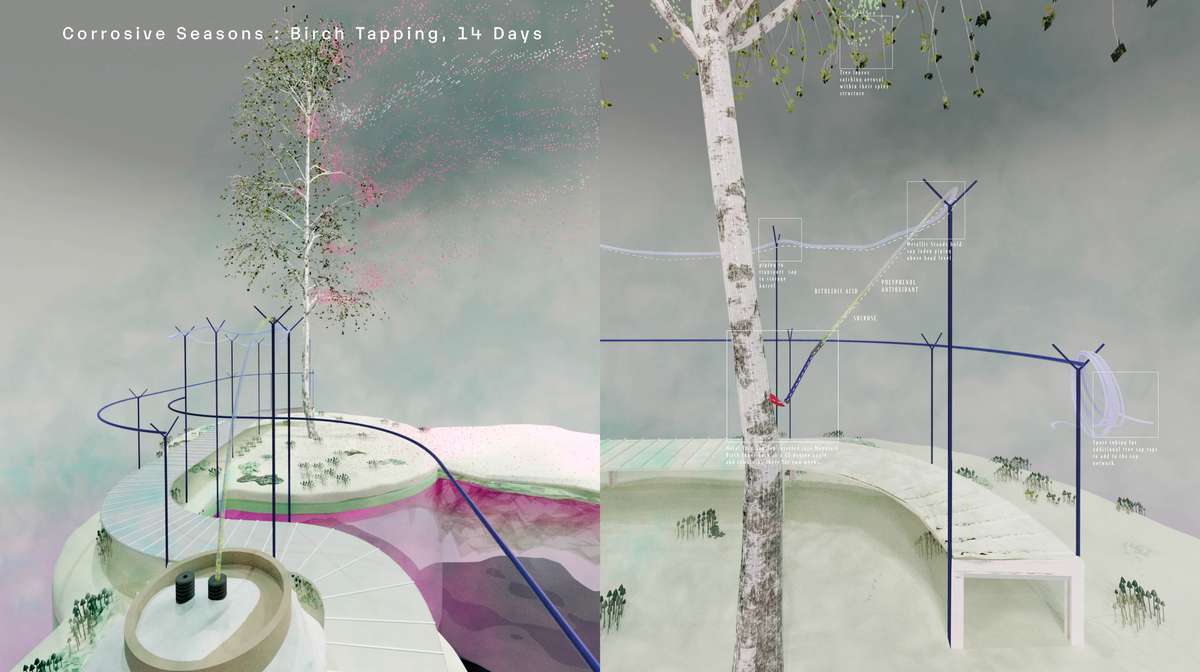
Tree Sap Tapping : 14 Days - Cirrus clouds sit high in the sky, seeded by metallic aerosols, undetectable at the ground. This is the 14-day long season of birch tapping, which shifts each year as the Arctic spring warms. Performed by the birch tree, fungi, and a human companion, the sap is drawn from the tree as it stretches, awakening to spring. By taking the sap and tending the tree, humans embed themselves within the processes of exchange that form entanglements within this damaged ground.
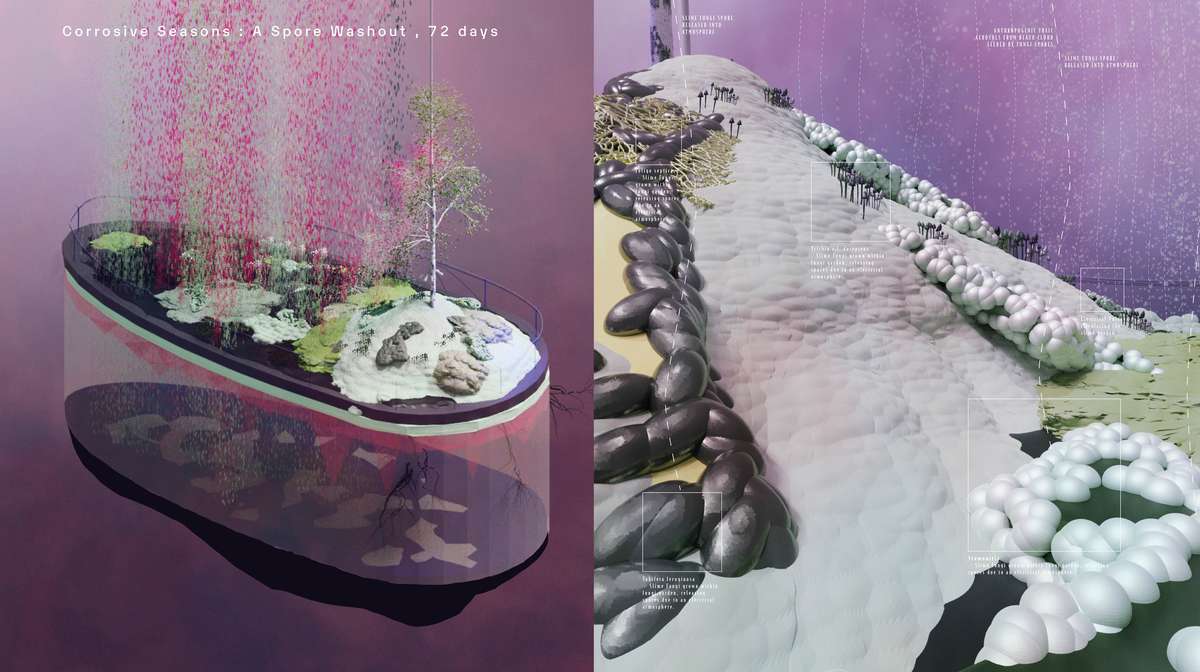
A Spore Washout - 72 Days In the turn of summer, the uncertain promise of the death clouds loom above. Islands within Nikel contain slime fungi gardens. As sulphur gathers, an electrical atmosphere is created by a sensing device, and the slime reacts by releasing a burst of spores. As the spores enter the toxic air, they take control of the clouds and encourage rain to form and fall. The death cloud is dispersed onto the ground, allowing the fungi spores to even further dominate the landscape.
WEIRD ASSEMBLAGES
WEIRD ASSEMBLAGES

- New alliances
My practice explores uncanny multispecies relationships that form around systems of pollution and spaces of residue. I explore landscapes through globalised infrastructures, questioning what landscapes and architectures may exist in the residual spaces of the technosphere we inhabit.
‘Weird Assemblages’ live fiercely and resiliently within the material traces of our infrastructural systems. They are an entanglement between bodies of air, bodies of toxins, living bodies and the bodies of the dead. Examples of these include the fauna that thrive in our polluted air; wild flowers that flourish in car exhausts; radiation eating berries; algae living through the carbon molecules in ice sheets and toxicity-resistant killifish. A multi-media catalogue of these weird assemblages will build a narrative of our landscapes as more-than-human assemblages of resilience, encouraging forms of architecture that both learn from these acts of resilience, and form a collective alliance within them.
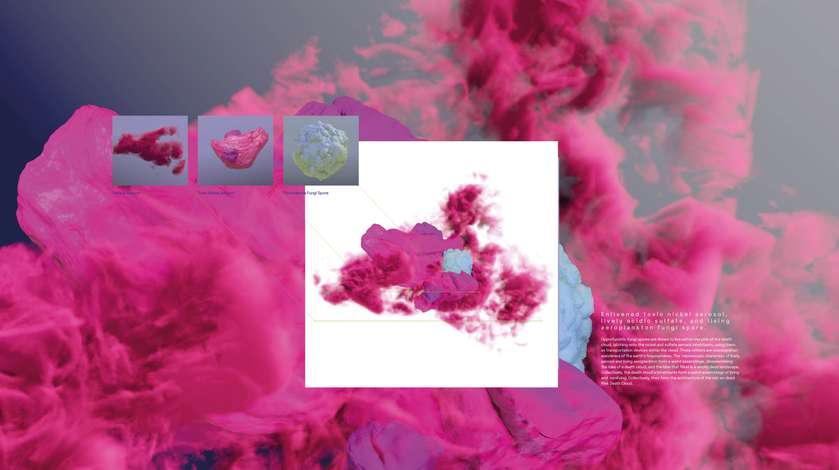
The Weird Assemblage of Nikel’s Death Cloud: Enlivened toxic nickel aerosol, lively acidic sulfate, and living aeroplankton fungi spore. Opportunistic fungi spores are drawn to live within the pink of the death cloud, latching onto the nickel and sulfate aerosol inhabitants, using them as transportation devices within the cloud.

The Metallic Footprints of the Death Clouds across the Kola Peninsula - In this land of accumulation, the earth, forests, rivers, and air of Nikel have become defined through metallic landscapes of death and residue. By tracing the toxic residue of the death cloud, we trace the footprint of the atmospheric weird assemblage of metal aerosol and conjoined fungal spore. As Mel Chen states, “This toxin is not alive, yet it enlivens morbidity in the fear of death.”
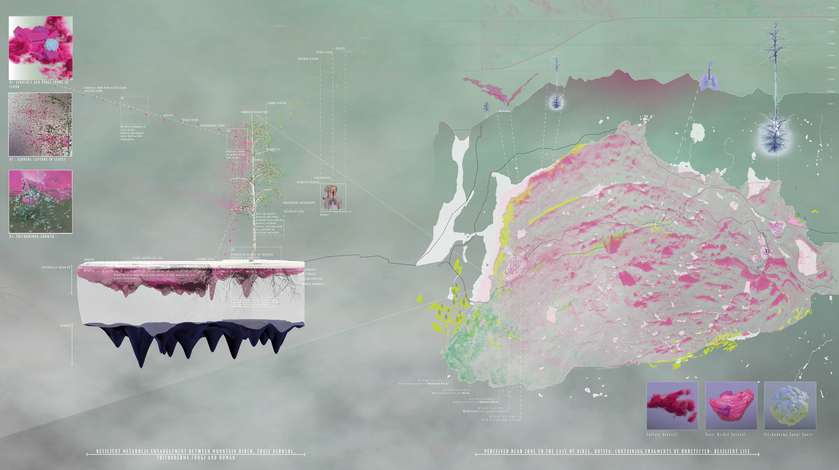
The Earthly Inhabitants of the Death Cloud - Mountain Birch trees have developed a metallic toxicity resistance within their saplings; within Nikel’s ‘dead zone.’ The leaves of these trees contain microscopic hairs that act as aerosol traps; catching the spores and toxic particles as they pass by, encouraging them to land in the soil. The weird assemblage spread from air to ground, with the tree and fungi entering a constant exchange of resilient chemicals within the tree roots.
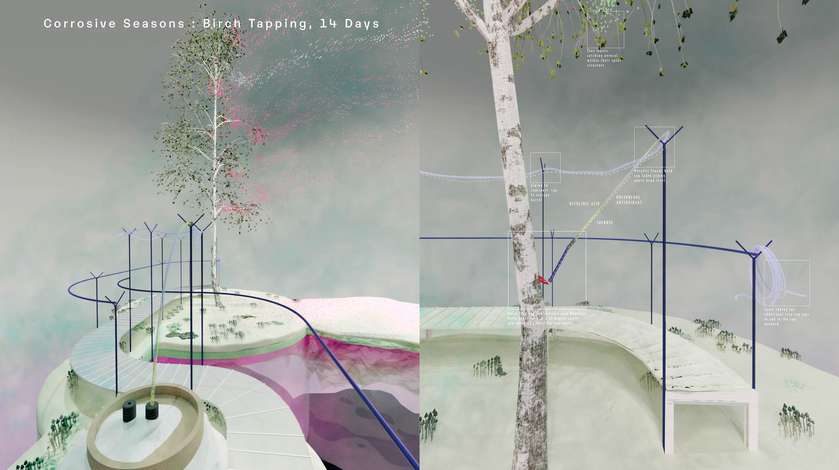
Tree Sap Tapping : 14 Days - Cirrus clouds sit high in the sky, seeded by metallic aerosols, undetectable at the ground. This is the 14-day long season of birch tapping, which shifts each year as the Arctic spring warms. Performed by the birch tree, fungi, and a human companion, the sap is drawn from the tree as it stretches, awakening to spring. By taking the sap and tending the tree, humans embed themselves within the processes of exchange that form entanglements within this damaged ground.
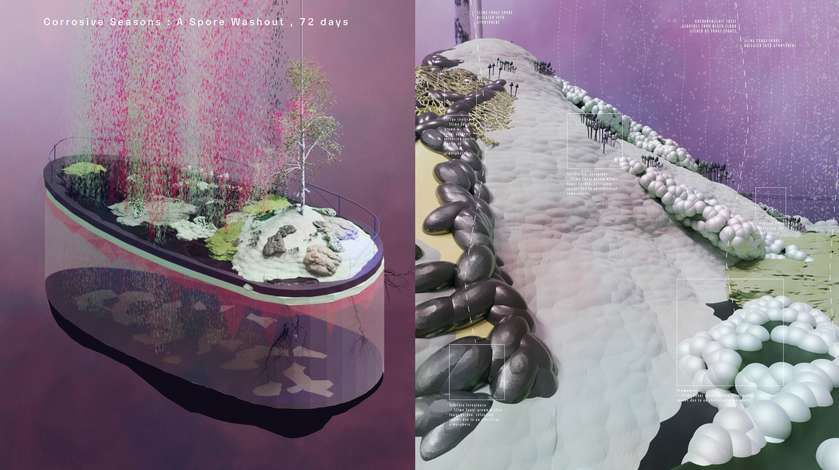
A Spore Washout - 72 Days In the turn of summer, the uncertain promise of the death clouds loom above. Islands within Nikel contain slime fungi gardens. As sulphur gathers, an electrical atmosphere is created by a sensing device, and the slime reacts by releasing a burst of spores. As the spores enter the toxic air, they take control of the clouds and encourage rain to form and fall. The death cloud is dispersed onto the ground, allowing the fungi spores to even further dominate the landscape.
